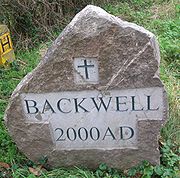
Village sign
Encyclopedia

Cast iron
Cast iron is derived from pig iron, and while it usually refers to gray iron, it also identifies a large group of ferrous alloys which solidify with a eutectic. The color of a fractured surface can be used to identify an alloy. White cast iron is named after its white surface when fractured, due...
or carved in wood
Wood
Wood is a hard, fibrous tissue found in many trees. It has been used for hundreds of thousands of years for both fuel and as a construction material. It is an organic material, a natural composite of cellulose fibers embedded in a matrix of lignin which resists compression...
, the designs are often made by the local community.
In 1924, King George VI recommended that the old custom of identifying villages with carved or painted name signs could be revived. In 1920, Biddenden
Biddenden
Biddenden is a village and civil parish in the Ashford District of Kent, England. The village lies on the Weald of Kent, some five miles north of Tenterden. It was centre for Wealden iron industry and also of clothmaking. During the reign of Edward III some Flemish clothworkers settled in the area...
had won a Daily Mail
Daily Mail
The Daily Mail is a British daily middle-market tabloid newspaper owned by the Daily Mail and General Trust. First published in 1896 by Lord Northcliffe, it is the United Kingdom's second biggest-selling daily newspaper after The Sun. Its sister paper The Mail on Sunday was launched in 1982...
competition for a sign featuring the two Biddenden Maids.
More villages followed, especially in 1953, the Coronation
Coronation
A coronation is a ceremony marking the formal investiture of a monarch and/or their consort with regal power, usually involving the placement of a crown upon their head and the presentation of other items of regalia...
of Queen Elizabeth II.
More signs have been put up due to the Millennium
Millennium
A millennium is a period of time equal to one thousand years —from the Latin phrase , thousand, and , year—often but not necessarily related numerically to a particular dating system....
. Also more signs were put up to commemorate the centenary of the formation of many councils. This has meant that more than half of the county villages have been identified.
The tradition of village signs started in Norfolk
Norfolk
Norfolk is a low-lying county in the East of England. It has borders with Lincolnshire to the west, Cambridgeshire to the west and southwest and Suffolk to the south. Its northern and eastern boundaries are the North Sea coast and to the north-west the county is bordered by The Wash. The county...
early in the 20th century when Edward VII suggested having signs to focus the identity of the villages around the Sandringham Estate. In 1929, Harry Carter, an art and woodwork master at Hamonds Grammar School (which now serves as the sixth form buildings for Hamond's high school
Hamond's High School
Swaffham Hamond's High School is a secondary school in Swaffham, Norfolk, England.The headteacher, Mrs. Yvonne Srodzinski who took over from Robert Young in 2002, has been suspended as of May 2009. Stuart Bailey has been appointed as the Interim Headteacher....
in Swaffham
Swaffham
Swaffham is a market town and civil parish in the English county of Norfolk. The town is situated east of King's Lynn and west of Norwich.The civil parish has an area of and in the 2001 census had a population of 6,935 in 3,130 households...
), carved a sign for his home town. When he died in 1983 he had carved over 200 town and village signs.
While the practice is now widespread, decorative village signs are still common in Norfolk and in the neighbouring county of Suffolk
Suffolk
Suffolk is a non-metropolitan county of historic origin in East Anglia, England. It has borders with Norfolk to the north, Cambridgeshire to the west and Essex to the south. The North Sea lies to the east...
as well as Essex
Essex
Essex is a ceremonial and non-metropolitan county in the East region of England, and one of the home counties. It is located to the northeast of Greater London. It borders with Cambridgeshire and Suffolk to the north, Hertfordshire to the west, Kent to the South and London to the south west...
and other eastern/east anglian counties. Some village signs are actually sculptures like the one at Capel St.Andrew, in Suffolk, which is constructed from scrap metal.

